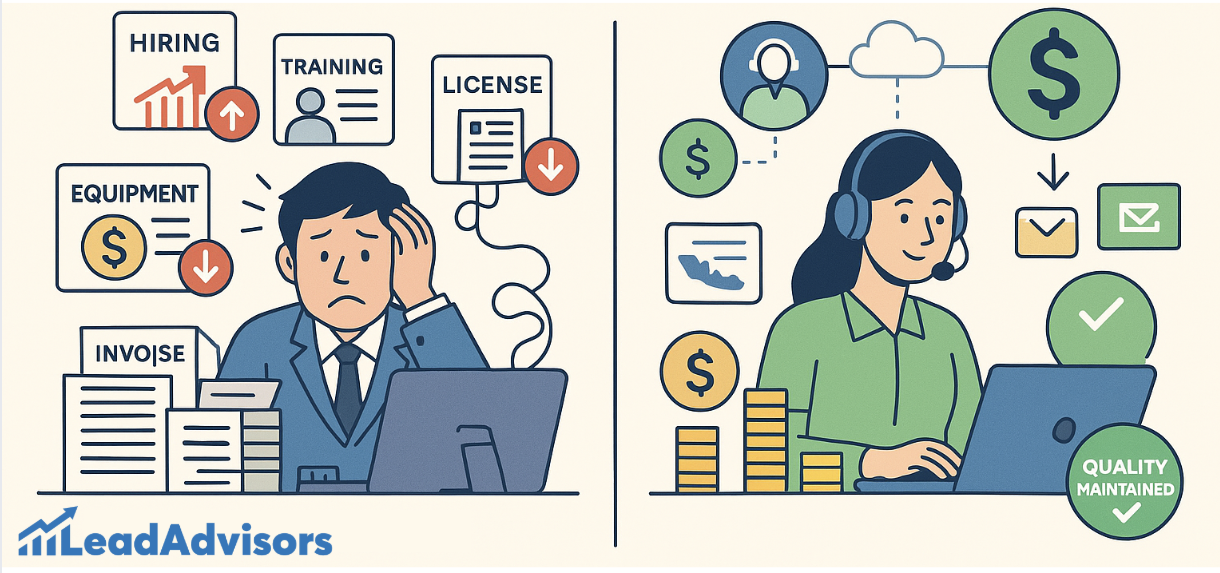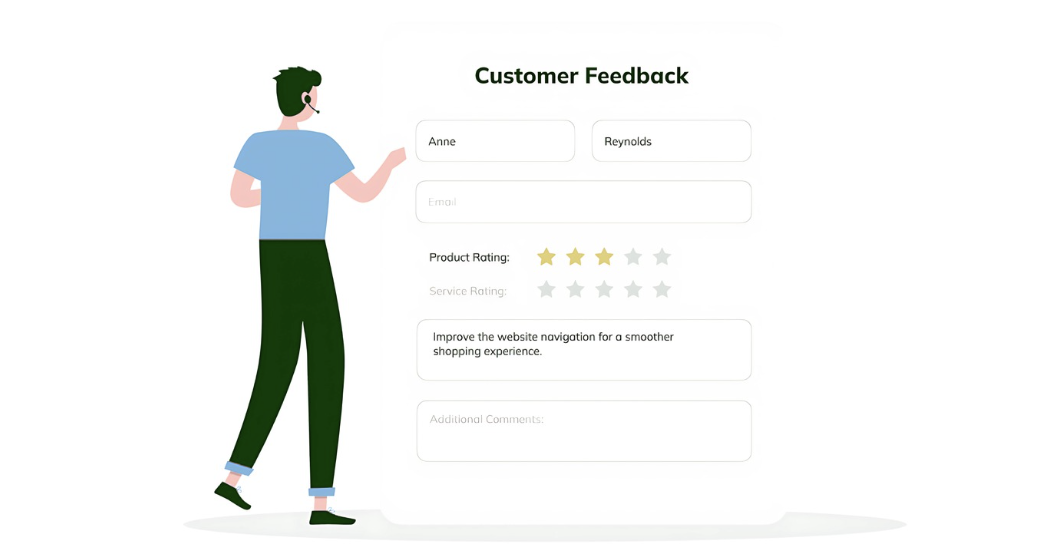You read that right: Call center outsourcing is the smartest move a business can make in 2025. If you’re still not sure if it’s the right move for you, you’re not alone.
At its heart, call center outsourcing refers to hiring a third party to operate your call center, such as receiving inbound calls, providing technical support, or making outbound calls to generate leads.
It was just voice support that it handled locally.” Today, it has transformed into a worldwide, omnichannel support with the help of AI-based tools, sophisticated technology, and stringent quality assurance processes.
So, is it still worth it? Absolutely. Outsourcing offers benefits such as cutting costs and access to specialized expertise.
In this article, we’ll examine the major benefits of call center outsourcing, what to look out for, and how to select an outsourcing partner. Let’s get started!
What Is Call Center Outsourcing?

Let’s break it down. Call center outsourcing refers to the practice of hiring a firm (the third party) to handle calls on behalf of a business, as opposed to taking care of it in-house. Tasks could involve answering the phones, making calls, taking chat requests, or even responding to emails or social messages (we call that multichannel or contact center support).
That configuration can take various forms. You can select dedicated agents who work only with your business or shared agents who field calls for many clients. Specialized configurations tend to be more expensive but provide a more customized experience. Shared models are more cost-effective and perfect for managing simple customer interactions or shifts in call volume.
You’ll also come across the terms onshore, nearshore, and offshore call centers. Here’s a quick breakdown:

- Onshore: The team is in your country.
- Nearshore: The team is in a neighbouring country, usually with a matching time zone.
- Offshore: The team is in a foreign country, often where labor is cheaper, so it offers another more affordable alternative.
Each model has pros and cons, but your choice will depend on your goals—whether you want to reduce costs, scale faster, or delight customers.
Is Call Center Outsourcing the Same as BPO?
Not exactly. The term business process outsourcing (BPO) is more general and encompasses accounting, HR, IT support, and other functions. Call center outsourcing is a subset of the greater BPO industry, concentrated specifically on the processing of customer service functions such as phone, email, and chat support.
7 Reasons to Outsource Your Call Center (2025 Edition)
Still not convinced that call center outsourcing is in your best interest in 2025? Let’s dissect the seven most compelling reasons that are leading brands, big and small, to call on center outsourcing and how they are benefiting from it.
1. Cost Efficiency Without Compromising Quality

The best part of call center outsourcing is that you will save money. Consider what it takes to operate an entire in-house team—hiring, training, tech setup, licensing, and running call center operations—and it adds up fast.
Contact center outsourcing companies like Invensis leverage existing infrastructure, experienced call center agents, and established processes. If you use offshore call centers, you’ll reduce your labor costs even more while still getting top-notch service—just make sure to vet the providers based on language skills, data handling, and cultural fit.
Also, watch for any hidden fees (such as premium holiday rates or after-hours support charges) that may affect your budget. But it’s still a thrifty way to keep your main operation running smoothly.
2. Scalability and Seasonal Flexibility

Business is dynamic, of course — some months are chill, while others (hi, holiday season!) are pure chaos. With contact center outsourcing, you can also add or reduce the size of your support team.
Looking for an additional 20 center agents for Black Friday? Or, you know, a couple of extras for your new product launch? A great center outsourcing partner provides you with that flexibility, minus the hassle of hiring new agents or training existing ones. Time zones? No problem. And thanks to global coverage, you get ubiquitously available support.
3. Access to Specialized Talent and Technology

Are you looking for agents who are fluent in five languages, well-versed in HIPAA regulations, or experts in providing the best tech support? With call center outsourcing, you don’t need to recruit or train your staff from scratch—you automatically gain access to a wealth of expertise.
Most contact center outsourcing firms are already ahead of the curve, utilising futuristic technologies such as AI chatbots, IVRs, real-time analytics, and CRM software. This equals better customer engagement and fewer bottlenecks.
4. Faster Implementation and Operational Efficiency
Want to get your support channel up and running quickly? With outsourcing, you can skip the lengthy hiring process and jump right into production. Templates, trained outsourced agents, and optimized workflow have already been set up by most outsourcing companies.
Desk support or back office support, they have your back for both. That’s how startups and up-and-coming brands launch quickly without compromising speed or quality.
5. Improved Customer Experience (CX) Through Consistency

When it comes to customer experience, it’s the same old story: it’s always about consistency. Outsourcing a call center helps provide standard scripts, monitor performance, and is open 24/7. That translates into fewer dropped calls from customers, shorter wait times, and happier customers.
Can you enable support in multiple languages or by email, phone, chat, or social media? Today’s contact center outsourcing provides the continuous, omnichannel support that your customers crave.
6. Data-Driven Decisions with Analytics and Reporting
Great service doesn’t just occur — it’s quantified. Most outsourced services come with specific analytics, categorizing calls, sentiment tracking, call recordings, and the ability to run customer feedback, all of which contribute to improving customer satisfaction over time.

With that data, you can fine-tune your scripts, note typical customer questions, and provide more personalized, intelligent support. Bonus: It is also helpful for quality assurance and compliance.
7. Better Risk Management and Compliance

Let’s face it—compliance is complex. Your outsourcing partner is probably already ahead on these standards, whether they’re GDPR, HIPAA, or PCI-DSS.
Good quality call center outsourcing companies also make their mark in data protection, disaster recovery, and business continuity to ensure that your business will always run, no matter the circumstances.
Risks and Challenges of Call Center Outsourcing
There’s no denying that call center outsourcing can have huge benefits, but as is the case with any business decision, there are some challenges involved. It’s best to know all of the risks ahead of time so you won’t be frustrated later.
Lack of Brand and Product Knowledge

The Problem:
As we’ll discuss later, when you work with outsourced call centers, the agents may not immediately understand your brand’s tone, values, or quirky product facts.
The Impact:
This mismatch can lead to mechanically sounding interactions and overall diminish customer satisfaction.
The Fix:
Opt for center outsourcing companies that value training and onboarding. As part of your sub-brands, share brand guidelines, FAQs, and tone-of-voice documents, and monitor with real-time feedback.
Loss of Control Over Customer Experience
The Problem:
You are outsourcing your call center operations and entrusting another party to handle your version of great service.
The Impact:
However, without tight alignment, service quality, tone, and execution may differ, which affects the overall customer experience.
The Fix:
Establish measurable KPIs, communicate openly with your outsourcing partner, and periodically perform quality assurance checks to ensure the quality remains consistent with your standards.
Communication Gaps Between Internal and External Teams
The Problem:
When you’re working with a third-party vendor, you can become disconnected from your in-house workers and the outside staff, especially if you’re in different time zones.
The Impact:
This slowness can lead to duplicated effort, missed updates, or delayed decisions.
The Fix:
Keep everyone on the same page with shared dashboards and project tools, dedicate a liaison to track data, and put in place regular sync meetings.
Language and Cultural Barriers
The Problem:
Even advanced call center agents working at overseas call centers could struggle with accent clarity, wording or understanding customer tone.
The Impact:
Misunderstandings can cause confusion or frustration, especially about sensitive topics.
The Fix:
Vet agents for language, cultural understanding, and empathy. Think about in-house spot-checks of call records or co-building scripts that reflect your audience.
Data Security and Compliance Risks
The Problem:
Handing over customers’ sensitive information to a third-party provider raises data security and regulatory warning signs.
The Impact:
A security incident or loss of compliance with regulatory requirements, such as HIPAA or GDPR, can harm your brand and may even create legal exposure.
The Fix:
Do business only with center outsourcing providers that provide enterprise compliance, business continuity planning, and transparent reporting.
How to Stay Ahead of These Risks
When it comes to call center outsourcing, price is just part of the story. The top outsourcers invest in agent training, security features, and seamless collaboration tools. Prefer partners who are an extension of your brand rather than just a vendor.
How Call Center Outsourcing Works (Step-by-Step)
So, you’ve bought into the call center outsourcing concept, but how does it work? We will walk you through the entire process so you know exactly what to expect.
Step 1: Choose the Right Vendor
It begins with the choice of a primary outsourcing partner who shares your industry, values, and customer requirements. Whether you seek offshore call centers or local crews, weigh their tech capabilities, industry expertise, and testimonials.
The top-notch outsourcing agencies will interview you about your operation and help you focus on a solution that will work well for you. Pro tip: Inquire about their agent training and communication process up front.
Step 2: Set SLAs and Contract Terms
After you find the right fit, it’s time to set your service level agreements (SLAs). These delineate such expectations as average handling time, first-call resolution, customer satisfaction targets, and how and when to escalate issues.
You would also want to include data handling requirements, quality assurance parameters, compliance (such as standards set by HIPAA or GDPR), and backup systems for business continuity in your contract.
Step 3: System Integration and Knowledge Transfer
Now, the setup begins. Your team will collaborate with the vendor to add features such as CRM, help desk, and call tracking systems to streamline customer interactions.
You’ll also use this phase to share product information, brand guidelines, FAQs, and templates with outsourced agents who need to represent your business accurately and confidently.
Step 4: Ongoing Training and QA
Call center outsourcing is not a “set it and forget it” proposition. Successful ones have regular training, “refresher” sessions, and soft skill coaching—ESPECIALLY if you’re talking tech support or taking tough inbound calls.
Live call monitoring and regular quality assurance checking ensure everything stays on track, and internal teams can easily review call logs and offer feedback.
Step 5: Track Performance with Reports and Dashboards

All vendors offer real-time dashboards and weekly or monthly reports. These display stats such as call volume, wait times, rate of resolution, and average customer satisfaction scores.
For instance, a retail brand may receive a weekly dashboard of agent performance, support trends, and training gaps to help it optimize its call center operations.
Pro Tip: The better you work with your outsourcing partner, the more your call center solutions will align with your business objectives. Consider them as part of your team, not a vendor.
When You Should Consider Outsourcing
Are you wondering whether now is a good time to consider call center outsourcing? Here are some typical situations where companies gain the most from working with an experienced outsourcing team.
1. You’re Scaling Fast or Expanding Globally
When your business expands rapidly—or into a large number of markets—it’s difficult (and costly) to hire, train, and manage an expanded in-house team. Outsourcing companies enable you to scale without the growing pains, providing a flexible workforce that is already trained and available to answer calls.
And if you are going global, many contact center outsourcing services already have multilingual agents and experience with cross-border regulations.
2. You’re Dealing with High Turnover or Training Costs
If we’re being honest with ourselves, there is no shortage of churn in running a call center. The costs mount up between recruitment, onboarding, and continuous coaching, especially for many small and mid-sized businesses.
Back-office outsourcing and call center outsourcing do the heavy lifting. They manage hiring, offer built-in training programs, and even include performance tools, such as quality assurance and coaching sessions.
3. You Need Multilingual or After-Hours Support
If your clientele is spread across time zones and speaks various languages, you require 24-hour coverage, which is difficult to obtain with only your in-house team.
Many answering services for outsourced call center services offer 24/7 support with multilingual coverage, which means that you can enhance your customer support and response time without significantly increasing your labor costs.
4. You Require Industry-Specific Expertise
Some industries, such as healthcare, fintech, or SaaS, demand deep product know-how or strict regulatory compliance. That’s where outsourced call centers can be a dream come true. Numerous suppliers can also provide trained agents with particular expertise in technical support, insurance, finance, or HIPAA/GDPR.
Whether it’s agents who know how to talk to the API or someone who can walk patients through a medical claim, outsourced call centers are an easy way to access the talent without building everything from the ground up.
Alternatives to Outsourcing — Is CCaaS a Better Fit?
Not sure if call center outsourcing is right for you? There’s another option worth considering: Contact Center as a Service (CCaaS).
CCaaS is a cloud-based platform that gives your business access to contact center operations, like voice, chat, email, and social media support, without owning or managing the infrastructure. It’s ideal for companies that want to keep their outsourcing customer service operations in-house but still benefit from cutting-edge tools like AI, automation, and real-time reporting.
So, how does it compare to outsourced call centers? Here’s a quick breakdown:
CCaaS vs. Outsourced Call Center: Which One Fits Your Business?
Feature/Need | CCaaS | Outsourced Call Center |
Control Over Agents | High – Managed by your team | Low – Managed by vendor |
Setup Speed | Fast cloud deployment | Fast with pre-trained teams |
Cost | Lower long-term costs with in-house handling | Lower upfront, variable over time |
Tech Tools | Advanced (AI, analytics, omnichannel) | Often included, varies by provider |
Scalability | Flexible with platform features | Flexible with staffing options |
Staffing | You provide the team | The vendor offers trained agents |
Best for | Tech-savvy, process-heavy businesses | Companies needing a full operational lift |
Leading CCaaS Platforms to Explore
If you’re leaning toward CCaaS, top providers like Sprinklr, Dialpad, and Vonage offer cloud-based solutions packed with features like AI bots, natural language processing, sentiment tracking, and unified customer experience tools.
These platforms are great if you want to retain control, already have an in-house team, and need to scale tech, not people. But they require training and ongoing management, so they’re not a completely hands-off solution.
TL;DR:
If you want a fully managed experience with trained agents and built-in customer support services, call center outsourcing is your go-to. But if you’ve got the team and want flexibility, CCaaS could be a better fit.
Best Practices for Managing an Outsourced Call Center
Once you’ve made the leap into call center outsourcing, the real work begins—managing it effectively. The good news? With the right systems and mindset, your outsourcing partner can feel like a true extension of your brand.
1. Document Everything and Align on SLAs
Clear documentation is your best friend. From workflows and escalation protocols to FAQs and tone-of-voice guidelines, having everything in writing keeps everyone aligned.
Also, make sure your service level agreements (SLAs) include measurable goals, such as response times, resolution rates, and customer satisfaction targets. This will create transparency and accountability for both you and your center outsourcing partner.
2. Use Centralized Tools for Communication and CRM Integration
Whether you manage one vendor or several, a unified platform keeps the chaos in check. To enable smooth customer interactions, make sure your contact center is synced with your CRM, ticketing system, and internal chat tools.
That way, both in-house and outsourced call centers can track updates, share notes, and provide consistent support in real time.
3. Monitor Performance and Share Insights Regularly
Don’t wait until the end of the quarter to check in. Regular reporting dashboards—tracking metrics like first call resolution, wait times, and customer feedback—help you spot trends early.
Make it a habit to review this data together with your outsourcing partner, and adjust training or processes based on what the numbers tell you.
4. Build a Feedback-Driven Coaching Culture

Your call center agents, whether internal or outsourced, want to succeed. Encourage two-way feedback, listen to agent suggestions, and recognize wins. A culture of coaching—supported by ongoing quality assurance—makes for better morale and a stronger customer experience.
Tip: Don’t outsource everything. Keep high-touch, high-value customer support services, like VIP accounts or sensitive cases, handled by your in-house team for better control and relationship-building.
Conclusion
There you have it—call center outsourcing isn’t just a cost-cutting move. It’s a smart, strategic way to grow your support operations, scale faster, and deliver a consistent customer experience without overloading your internal team.
From gaining access to specialized skills and 24/7 support to improving quality assurance and simplifying hiring headaches, outsourcing can be a powerful partner in your growth journey. But remember—it’s not a one-size-fits-all solution. Some tasks are better handled by your in-house team, especially when customer relationships are on the line.
Whether you’re exploring outsourcing services for the first time or ready to upgrade from your current setup, make your decision intentionally and with the right guidance.
Want to see what outsourcing could look like for your business?
Talk to the team at LeadAdvisors for tailored call center outsourcing solutions—or book a free consultation to explore your options. Let’s help you scale smarter.













